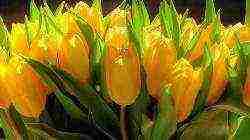Content
- 1 1. Bobo
- 2 2. Vanille Fraise
- 3 3. Wim's Red
- 4 4. Grandiflora
- 5 5. Diamand Rouge
- 6 6. Kyushu
- 7 7. Limelight
- 8 8. Little Lime
- 9 9. Magical Candle
- 10 10. Pink Diamond
- 11 11. Pinky Winky
- 12 12. Sundae Fraise
- 13 13. Silver Dollar
- 14 14. Phantom
- 15 15. Fraise Melba
- 16 Description
- 17 Panicle hydrangea: varieties, photos
- 18 Breeding hydrangea paniculata
- 19 The best varieties of panicle hydrangea for the Moscow region: photo and description
- 20 AGM Winning Panicle Hydrangea Varieties: Photos and Names
- 21 The most beautiful varieties of panicle hydrangeas: photo and description of flowers
- 22 Dwarf bushes of panicle hydrangeas
- 23 New varieties of garden panicle hydrangeas
- 24 How to care for panicle hydrangea in the country (with photo)
- 25 How to grow panicle hydrangea: bush formation
- 26 How to form a panicle hydrangea on a trunk
- 27 How to properly prune a panicle hydrangea in spring
- 28 Panicle hydrangea in landscape design: what to plant next to the bushes
- 29 Hydrangea: varieties and types.
- 29.1 Panicle hydrangea in the garden
- 29.2 Benefits of panicle hydrangea.
- 29.3 Panicle hydrangea care and reproduction
- 29.4 Panicle hydrangea. Top 10 best varieties.
- 29.5 1st place: panicle hydrangea Polar Bear.
- 29.6 2nd place: panicle hydrangea Limelight.
- 29.7 3rd place: Panicle hydrangea Vanilla Freise
- 29.8 4th place: panicle hydrangea Silver Dollar
- 29.9 5th place: panicle hydrangea Kuishi
- 29.10 6th place: Bobo panicle hydrangea
- 29.11 7th place: Panicle hydrangea Phantom
- 29.12 8th place: panicle hydrangea Mega Mindy
- 29.13 9th place: panicle hydrangea Grandiflora
- 29.14 10th place: panicle hydrangea Vims Red
- 29.15 Panicle hydrangea care and pruning in a short video review:
Not sure which flower to plant on your site? Pay attention to the best varieties of panicle hydrangea. These luxurious plants will leave no one indifferent.
Panicle hydrangea differs from the equally popular tree-like inflorescence mainly in the form of inflorescences: they resemble a wide pyramid. Inflorescences usually consist of small (bisexual) and large (sterile) flowers. Moreover, during flowering, they gradually change their color.
1. Bobo
Dwarf variety Bobo in 2011 at the flower show in Belgium received the award "Best variety". During the abundant and prolonged flowering of this hydrangea, the color of its petals changes from white-yellow to pale pink.
Due to its low growth, the Bobo hydrangea is suitable for growing in containers that can be placed on the balcony or summer terrace. It is desirable that this be a semi-shaded place, since in the bright sun the hydrangea inflorescences become smaller. At the same time, it is important that the shrubbery is protected from gusty winds.
|
Appointment |
Bush height (cm) |
Bush width (cm) |
Flowering period |
Peculiarities |
|
July to September |
Plant winter hardy, but the roots young bushes for the winter you need mulch. |
|||
2. Vanille Fraise
This variety is suitable only for a large flower garden: in a short time, the shrub can reach a height of 2 m.Large inflorescences (about 30 cm in diameter), similar to clusters of lilacs, amaze with their unusual color: the petals can be snow-white and rich crimson at the same time.
Hydrangea Vanilla Fries looks best in mixborders, where it is combined with phlox, stonecrop, highlander, cuff and hosts of large varieties.
|
Appointment |
Bush height (cm) |
Bush width (cm) |
Flowering period |
Peculiarities |
|
July to September |
Withstands downgrade temperature up to -40 ° С, fast recovering, even will freeze. |
|||
3. Wim's Red
The flowers of this hydrangea are collected in conical inflorescences about 35 cm long, which exude a pleasant honey aroma. From the beginning of summer until the very frost, the inflorescences gradually change color: the newly blossoming petals are white, over time they turn pink, and in the fall they become deep red.
|
Appointment |
Bush height (cm) |
Bush width (cm) |
Flowering period |
Peculiarities |
|
June to October |
Prefers bright light, but can grow and in partial shade. On acidic soils flower coloring more intense. Does not need in a winter shelter. |
|||
4. Grandiflora
The flowers of the Grandiflora hydrangea are collected in huge pyramidal panicle inflorescences. When blooming, they are creamy white, in full bloom they are snow-white, by the end of summer they become pinkish, and in autumn they are greenish-red.
|
Appointment |
Bush height (cm) |
Bush width (cm) |
Flowering period |
Peculiarities |
|
From mid-June to October |
Prefers penumbra. Grows well in urban conditions, but under securing abundant watering. In young plants for the winter recommended harbor near-trunk circle. |
|||
5. Diamand Rouge
This erect shrub has a fairly compact shape. On it there are large inflorescences (up to 40 cm long), first white, and then incredibly rich crimson-red color. No other panicle hydrangea has such a bright shade!
The leaves of the Diamond Rouge hydrangea look no less impressive: in spring and summer they are green, and in autumn they turn orange.
|
Appointment |
Bush height (cm) |
Bush width (cm) |
Flowering period |
Peculiarities |
|
From the end of June to September |
Hydrangea stable to urban conditions and frost, does not need in the shelter. Poorly tolerates drought. |
|||
6. Kyushu
This tall shrub with a rounded dense crown and wide-pyramidal panicle inflorescences (up to 25 cm long) is grown in city parks and in personal plots. Kyushu hydrangea flowers are white and very fragrant. A distinctive feature of the hydrangea of this variety is glossy dark green leaves located on red petioles, which turn yellowish in autumn.
|
Appointment |
Bush height (cm) |
Bush width (cm) |
Flowering period |
Peculiarities |
|
From mid-June until mid-September |
Growing fast frost hardy (up to -25 ° С), demanding on fertility and soil moisture. Attractive for insects. |
|||
7. Limelight
This plant has gained popularity among landscape designers due to its very strong shoots, which, without stands and supports, can perfectly withstand heavy inflorescences.
Large inflorescences-panicles at the beginning of flowering in the shade are greenish (lime-colored - hence the name of the variety), and in the sun - pure white. At the end of flowering, they turn pink. Limelight hydrangea has slightly velvety leaves. In summer they are green, and in autumn they take on a purple hue.
|
Appointment |
Bush height (cm) |
Bush width (cm) |
Flowering period |
Peculiarities |
|
From the end of July to September |
Hydrangea photophilous and hygrophilous. Young plants need shelter for the winter, with age winter hardiness rises. |
|||
8. Little Lime
This short shrub resembles a Limelight hydrangea with its inflorescences: at first they are whitish-pistachio (in the open sun - light green), and by the end of flowering they become slightly pinkish. However, these two varieties mainly differ only in the size of the bush.
|
Appointment |
Bush height (cm) |
Bush width (cm) |
Flowering period |
Peculiarities |
|
July to October |
Plant well hibernates without shelter, prefers wet, drained and fertile soil, transfers stagnant water. |
|||
9. Magical Candle
This plant is characterized by a spreading crown, elongated, slightly toothed leaves and large pyramidal inflorescences that exude a pleasant aroma. When blooming, the flowers are white-cream (sometimes slightly greenish), then gradually acquire a pink tint, and in autumn they become crimson.
|
Appointment |
Bush height (cm) |
Bush width (cm) |
Flowering period |
Peculiarities |
|
From mid-June to September |
Prefers penumbra and acidic soil. Tolerates well pruning and not afraid of frost. |
|||
10. Pink Diamond
On a rather tall, erect bush, large panicle inflorescences bloom among light green rough leaves. At first, the flowers are white, then gradually turn pink and by autumn they become red-crimson.
|
Appointment |
Bush height (cm) |
Bush width (cm) |
Flowering period |
Peculiarities |
|
From the end of July until early October |
In early spring needs in pruning. Plant winter hardy, but in a young his age need shelter. |
|||
11. Pinky Winky
This variety was bred more than 10 years ago, but to this day it does not leave the list of the best varieties of panicle hydrangea. A shrub or small tree with a broadly rounded crown every year adds 30 cm in growth. On its powerful stems there are panicle inflorescences, which are white at the beginning of flowering, and by autumn they acquire a pink-purple hue.
Pinky Winky's hydrangea leaves are no less attractive: in summer they are green, slightly rough, and in autumn they turn purple-red.
|
Appointment |
Bush height (cm) |
Bush width (cm) |
Flowering period |
Peculiarities |
|
From the end of June to September |
Mature bushes withstand frosts down to -25 ° С, and young in winter may freeze, therefore need in shelter burlap or spruce branches. |
|||
12. Sundae Fraise
The bush of this hydrangea is very compact, dense and even. Shoots are red-brown. The leaves are pubescent, especially along the veins. The flowers are white at first, and by the end of summer they become lilac-pink.
|
Appointment |
Bush height (cm) |
Bush width (cm) |
Flowering period |
Peculiarities |
|
From mid-June until October |
The plant is resistant to disease and pests not afraid of frost. Prefers fertile soil, best of all grows in partial shade. |
|||
13. Silver Dollar
This tall shrub got its name from its unusual inflorescences: at the beginning of flowering, they are white with a greenish tint, and by autumn they become silvery pink. Emerald green ovoid leaves are also attractive.
|
Appointment |
Bush height (cm) |
Bush width (cm) |
Flowering period |
Peculiarities |
|
July to September |
Withstands frosts down to -29 ° С, but in the first year for the winter root plant system need to protect using mulch. Thanks to strong shoots plant does not require garters. |
|||
14. Phantom
The variety is highly regarded for its lush flowering and unique honey aroma, which exude beautiful flowers. In summer, the inflorescences are light cream, and by autumn they become pinkish, while their tops turn yellow. The petals of this plant are slightly different from other hydrangeas: they are slightly elongated and not so close to each other.
|
Appointment |
Bush height (cm) |
Bush width (cm) |
Flowering period |
Peculiarities |
|
July to September |
In the middle lane young plants can freeze, therefore their harbor a layer of mulch. |
|||
15. Fraise Melba
For the first time the variety was presented in June 2014 at the exhibition "Gardens and People" in Russia. Due to its unpretentious cultivation and lush flowering, this hydrangea quickly gained popularity.
This shrub with a spreading crown, vertical shoots and unusual pointed foliage of a dark green color, compared to other hydrangeas, grows rather slowly, but with good care in adulthood, it can reach 2 m.
The overflow in the color of the inflorescences looks very impressive in the hydrangea Fries Melba. At first they are milky white, then they acquire pale pink tones, and by the end of flowering they become wine red. At the same time, flowers of 3 different shades often bloom in one inflorescence.
|
Appointment |
Bush height (cm) |
Bush width (cm) |
Flowering period |
Peculiarities |
|
July to September |
Plant branches very dense therefore do not require garters. To inflorescences were large annually in spring should be carried out short cut. |
|||
What wonderful panicle hydrangeas decorate your flower garden?
 It happened in a distant year BC. A baby was born who was destined to become a great Buddha.
It happened in a distant year BC. A baby was born who was destined to become a great Buddha.
Instead of rain, sweet nectar poured down from the sky onto the earth, and unusually beautiful flowers fell.
The Japanese call them audzisai and believe that the wondrous plant brings good luck and protects the house from evil forces.
…
Description
A flower from a Japanese legend came to Europe in the middle of the 18th century and was named hydrangea.
Shrub or small tree from the family of saxifrage there are thirty-five species.
Palm most gardeners give panicle hydrangeas. There are several reasons for this.
- The plant is unpretentious... Grows well in ecologically unfavorable areas. She is not afraid of swampy and clayey soils. The shrub feels great in the shade and under the scorching rays of the sun. Adapted for cultivation in any region of the country.
- Increased frost resistance allows you to grow flowers in the conditions of the Russian north. Hydrangea does not need insulation. Some varieties can withstand temperatures up to - 35 degrees.
- Fast growth allows you to equip the landscape in a short time. Hydrangea is a durable plant.
- Planting and grooming does not take long and extensive knowledge of horticulture. Even an inexperienced grower can grow a hydrangea.
Hydrangea paniculata depending on the variety, there can be two types:
- Tall (two to five meters) shrub with elliptical or rounded leaves with serrated edges.
- Small (up to ten meters) tree with a very dense crown of oval, velvety leaves to the touch.
Leaves panicle hydrangeas are rather large, from 5 to 15 cm long. They are located opposite. The outer side of the leaf is colored in various shades of green. On the reverse side, the leaves can be pale green or grayish.
All varieties grown in the middle lane of the country are deciduous. The evergreen panicle hydrangea grows only in regions with warm climates.
Root system panicle hydrangea is powerful and wide. Its border extends far beyond the crown. The roots of the plant are thick, but shallow. This must be taken into account when landing.
Bush has one barrel... He does not give overgrowth around him. The branches are long and thin.
At their ends are formed pyramidal panicles (hence the name of the species). Dense large cones are collected from many flat flowers. Inflorescences cover the entire bush. They reach 35 cm in length and 20-25 cm in width.
Flowers panicle hydrangeas are unusual. Instead of petals, the hydrangea has sepals.
An important fruiting function is performed by small nondescript white flowers. They are located in the center of the inflorescence and fall off early. In their place, a fruit resembling a vessel appears. The seeds are very small. They have a high germination capacity.
Fruitless flowers are designed to attract insects and delight the eye with wondrous beauty. Large (up to seven centimeters in diameter), various shades, they bloom from June to late autumn.
Hydrangea flowers several times per season change color... And since panicle hydrangea blooms for a very long time, flowers of different shades can often be seen on one bush. The spectacle is mesmerizing.
You can change the color of hydrangea paniculata on one's own... Using aluminum alum, sulfur, iron salts, you can conduct fascinating experiments and achieve a variety of shades. The garden will be decorated with blue, purple and even two-colored panicles.
Next, let's talk about panicle hydrangea: photos and varieties.
Panicle hydrangea: varieties, photos
They differ in plant height, flowering time, color and size of inflorescences.
When choosing a variety, you should consider climatic features of the region in which it is planned to grow hydrangea. Frost-resistant "Bobo", "Great Star", "Kiushu", "Polar Bear" will feel good in any region.
Heat-loving "Limelight" or "Medical Moonlight" are suitable for the southern regions.
Consider the best varieties of panicle hydrangea (description with photo), as well as relatively new species.
Grandiflora popular with Russian gardeners. Differs in rapid growth. During the year, it adds up to 25 cm. The inflorescences are pyramidal, long and wide. It begins to bloom late. When blooming, the flowers have a delicate cream color, in full bloom they become dazzling white. Under the autumn sun, they turn pink, then acquire a red-green color.
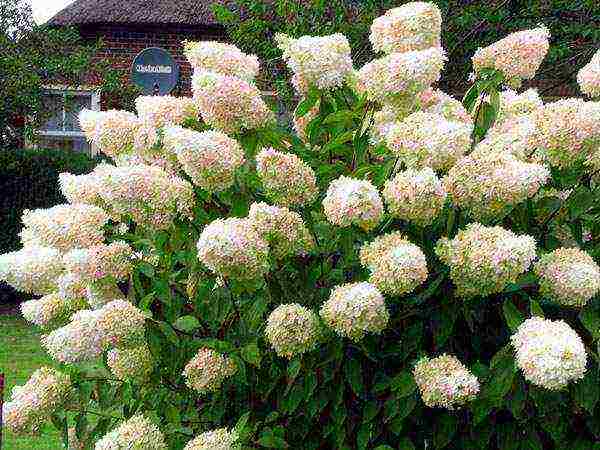
Kyushu - an elegant three-meter shrub with lush, smooth foliage.The inflorescences resemble arrowheads. The flowers are medium-sized, pale. The plant has a very pleasant delicate aroma and is a good honey plant.
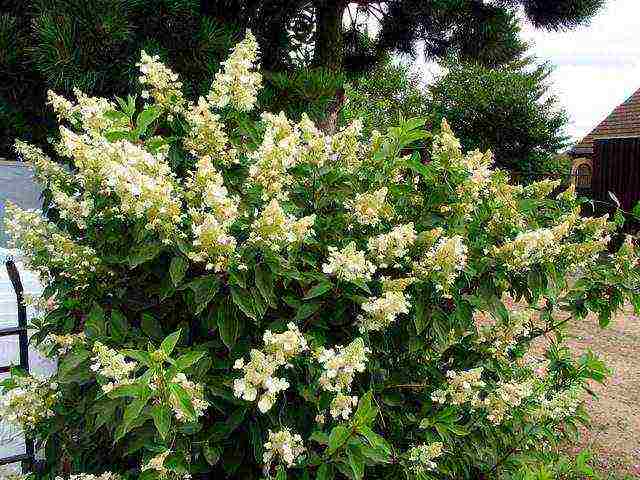
Limelight - a powerful shrub with large lush inflorescences. The initially greenish-yellow flowers take on a creamy white color over time. The plant is thermophilic. Loves the sun and open areas.
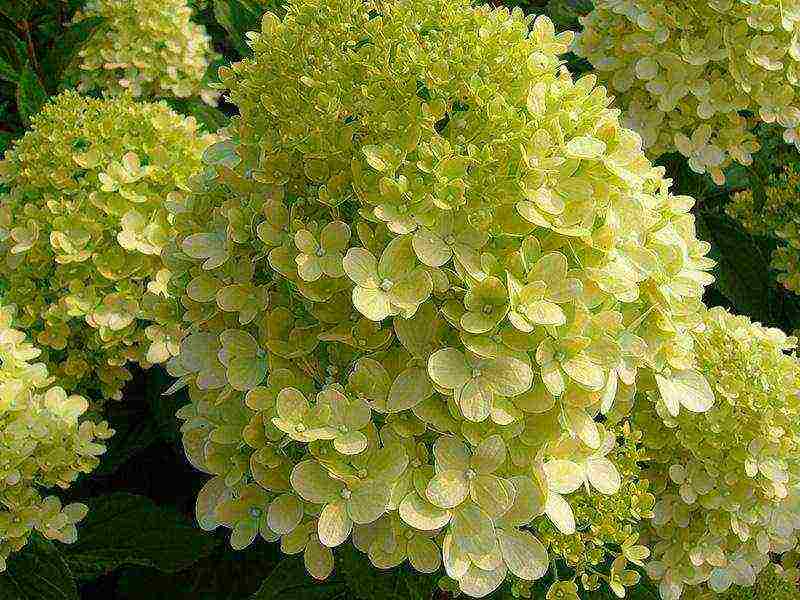
And here is a video about Limelight paniculata hydrangea.
Tardiva appreciated for late unusual flowering. A deciduous, frost-hardy shrub with a rounded crown that can grow up to two meters. Greenish buds appear in mid-July. They bloom slowly. Hydrangea blooms profusely from late September to November frost. Inflorescences are thin, narrow, pyramidal in shape.
They consist of a large number of small fruiting flowers. Large sterile flowers are at first white or creamy, with time they acquire a pink tint. If the autumn days are sunny, the inflorescences turn red brick or purple. At the end of flowering, they turn green again.
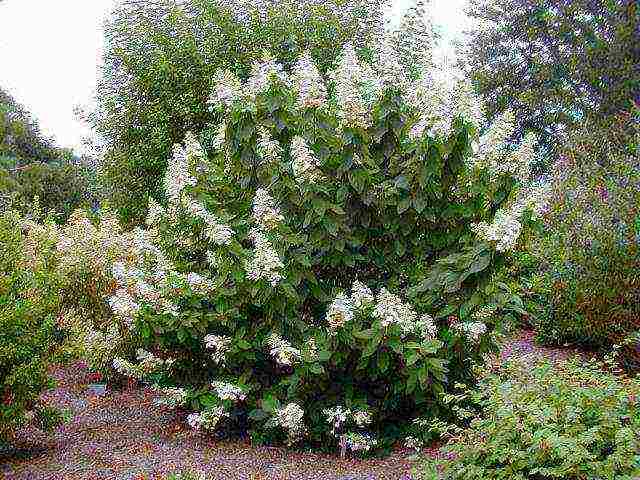
Bobo in 2011 he received an award at an exhibition in Belgium as the best new winter-hardy variety. He is not afraid of frost down to -34 degrees. It is considered a dwarf variety. The bush grows up to 70 cm. It blooms magnificently, but does not really like the sun. The inflorescences are conical. Changes in color from delicate lemon green to white and light pink.
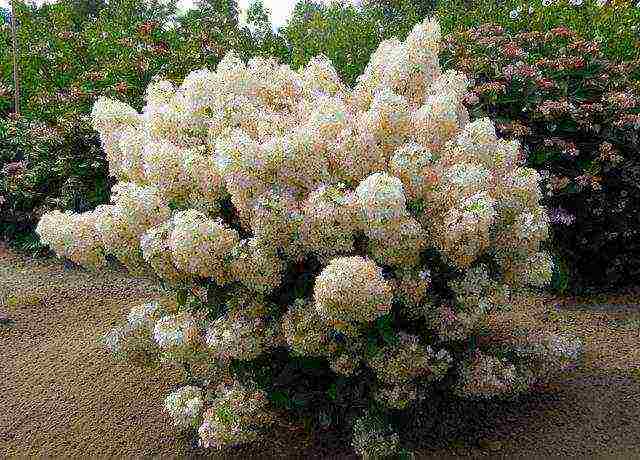
Precox are very fond of Japanese gardeners. It is gaining popularity in Russia as well. The earliest variety with a dense crown and rough leaves. Already in June will delight you with large white panicles
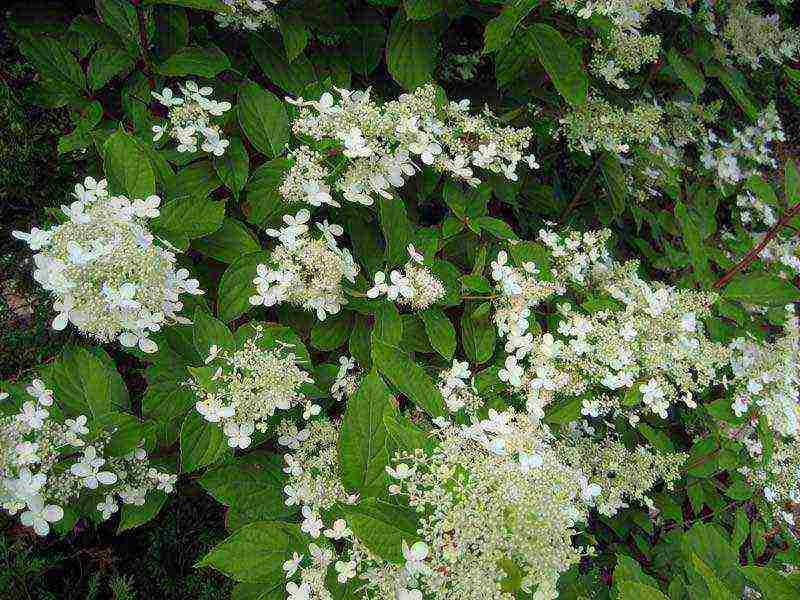
Vanilla Fries - a lush, spreading hydrangea with large pyramid-shaped inflorescences. It is considered a leader in sales. Late flowering shrubs are not afraid of severe frosts. White flowers quickly take on a rich pink hue.

Medical Moonlight (Magic Moonlight) lives up to its name. Creamy white, greenish huge inflorescences do not change color in autumn. But they change their shape. Rounded at the beginning of flowering, they gradually elongate and by autumn they acquire a conical shape. Blooms profusely from late June to early September.

Great Star attracts flower growers with unusual flowers. To some, they resemble a propeller. Others compare them to snow-white butterflies. The flowers are large, with a diameter of 8 - 10 cm. One of the few varieties that do not change color throughout the entire flowering. The variety grows well in adverse conditions in industrial cities, but prefers shade. The variety is frost-resistant.

polar bear - a new variety. It appeared in 2013 and immediately gained popularity among gardeners. White flowers in huge inflorescences look very impressive. A frost-resistant variety with strong shoots grows well in regions with harsh climates.
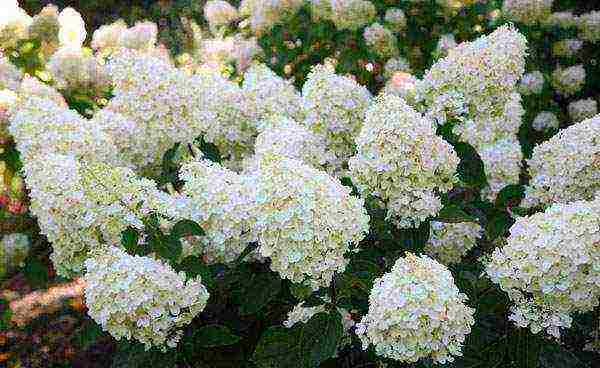
Diamond Rouge appreciated for its marvelous beauty and winter hardiness. Inflorescences are very large, up to 40 cm in diameter. White flowers gradually turn pink. A little later, they acquire a red hue, to which purple is added in the fall. Hydrangea of this variety blooms for a long time, therefore, flowers of different shades can be on the bush at the same time.

Fraz Melba - a wonderful novelty from last year. The flowers are sterile, so the inflorescences reach 40 cm in length. A dense cascade of milky-white flowers gradually changes color from delicate pink to deep red. The bush reaches two meters in height and blooms until freezing.

Variety of varieties panicle hydrangea, its unpretentiousness and ease of growing will satisfy both experienced and novice florists. To your attention a video about varieties of panicle hydrangea.
This video tells about varieties of panicle hydrangea.
Hydrangea paniculata - medicinal plant... It is recommended to drink tea made from dried flowers for colds and cardiovascular diseases. A decoction of the root has a diuretic effect. It is used for kidney and prostate diseases.
And in this video there is more information about the panicle hydrangea.
Hydrangea paniculata on video.
In all varieties of panicle hydrangea, in contrast to the tree, petiolate, large-leaved, ash and other forms, the inflorescences are elongated. They resemble fluffy panicles, which is why the species got its name from the owl. According to the description, the panicle hydrangea can only be compared with the oaky variety, but, of course, the heroine of this material wins in terms of brightness, density and duration of flowering.
The most favorite shrubs by gardeners: panicle hydrangea, chubushnik, lilac. Each shrub is good in its own way. But the hydrangea is still in the lead with this trio. First, she is a true flowering champion. Secondly, it grows and blooms without problems in partial shade, where the lilac and mock-orange will wither away. Thirdly, her hats adorn the garden exactly when almost everything has already faded, and only dahlias are waiting with trepidation for the end of the holiday - the first autumn frost.
Recently, new varieties of panicle hydrangeas appear literally every year. It is difficult even for specialists to understand this stream. There is nowhere to look at all forms "live", and even more so at new items, even abroad. It is expected that a collection of the best varieties of panicle hydrangeas will soon appear in the Botanical Garden on Prospekt Mira.
A photo of an adult panicle hydrangea with a detailed description is a rarity, nurseries do not spoil buyers with such gifts. So you have to collect information bit by bit. And, of course, at your own peril and risk, experiment yourself.
Breeding hydrangea paniculata
Previously, everything was simple with panicle hydrangea - in Russian noble estates and later in summer cottages, only one variety grew - 'Grandiflora'. He was brought to Europe from Japan in 1829 by the German physician Philipp Franz Balthasar von Siebold, who worked for several years on the islands in the Nagasaki region. Another old variety, 'Floribunda', which got to St. Petersburg from a Japanese nursery thanks to Karl Maksimovich in 1860, did not receive such wide distribution in our country. A little later, two more cultivars became known in Europe - ‘Rhaesok’ and ‘Kyushu’.
Their origin was all the same - Japanese.
The situation changed in the fifties of the prologue of the century, when two enthusiasts - Robert and Elena de Belder (Jelena and Robert de Beider) took up the selection of panicle hydrangeas. It is to them that the growers owe the appearance! masterpieces such as ‘Unique’, ‘Brussels Lace’ and ‘Pink Diamond’.
Breeders in Europe and the USA are still working with the legacy of the de Belders. So, for example, using plants from their arboretum, in the 1970s and 80s. Dutchman Pieter Zwijnenburg gave the world such beautiful varieties of panicle hydrangeas as ‘Phantom ', ‘Limelight’ and ‘Silver Dollar’. The first cultivar became famous for the largest inflorescences to date, the second for its extraordinary, lemon-green sterile flowers, the third for the spectacular appearance of a bush: large pyramidal inflorescences and strong, vertical shoots.
Next, you can familiarize yourself with the photos, names and descriptions of varieties of panicle hydrangeas popular with gardeners.
The best varieties of panicle hydrangea for the Moscow region: photo and description
'Brussels Lace'
The height of the bush is 2 m. The inflorescence is up to 30 cm long, conical in shape, the flowers are fertile and sterile. White, later turning pink. Blooms until October.
'Grandiflora'
The height of the bush is 2-3 m. The inflorescence is a wide cone, 20-30 cm long. The flowers of this variety of panicle hydrangea, suitable for the Moscow region, are sterile, creamy white, then pink. Blooms until October.
‘Great Star’ (‘Le Vasterival’)
The height of the bush is 2 m. The inflorescence is round, 15 cm in diameter. Among the fertile flowers are sterile, very large, white, in the form of a "propeller". Blooms until September.
‘Dart’s Little Dot’ (‘Darlibo’)
The height of the bush is 0.8-1 m. The inflorescence is spherical, 15 cm in diameter, the flowers are white, sterile and fertile. Blooms until October.
‘Kyushu’
Bush height 3 m. Narrow-conical, loose inflorescence, 20-35 cm long, white flowers, sterile and fertile. Blooms until mid-August.
‘Limelight’
The height of the bush is 2.3 m. The inflorescence is broad-conical, 30 cm long, the flowers are sterile, light green, then white. This one of the best varieties of panicle hydrangeas for the Moscow region blooms until early October.
‘Mega Mindy’ (‘Ilvomindi’)
The height of the bush is 1.8 m. The inflorescence is conical, up to 30 cm long. Most of the flowers are sterile. The color is white, then red-pink. Blooms until August.
‘Pinky Winki’
The height of the bush is 1.6 m. As you can see in the photo, this panicle hydrangea has a conical inflorescence, 20 cm long:
The flowers are sterile, white, then deep pink. It continues to bloom in October.
‘Pink Diamond’
The height of the bush is 2-3 m. The inflorescence is cone-shaped, up to 30 cm long. The flowers are sterile and fertile, white, then pink. It continues to bloom in October.
‘Phantom’
The height of the bush is 2 m. Look at the photo - this variety of panicle hydrangea has the largest inflorescence, conical-rounded, 30 cm long:
The flowers are sterile, white, then light pink. Blooms until October. Reminiscent of the 'Grandiflora' variety.
‘Floribunda’
The height of the bush is 2 m. The inflorescence is broad-conical, up to 40 cm long. The flowers are sterile and fertile, white. Blooms until October.
‘Vanille Fraise’ (‘Renhy’)
The height of the bush is 1.8 m. The inflorescence is broadly toxic, 30 cm long, the flowers are small, sterile, pale pink. This panicle hydrangea, recommended for the Moscow region, continues to bloom in October.
‘Silver Dollar’
The height of the bush is 1.7-4 m. The inflorescence is conical-rounded, up to 25 cm. The flowers are sterile, creamy white, then pink. It also blooms in October.
'Tardiva'
The height of the bush is 1.3-3 m. The inflorescence is conical, 25 cm long. The flowers are sterile and fertile, white. Blooms in October.
‘Unique’
The height of the bush is 2-3 m. The inflorescence is a wide cone, 25 cm long. One third of the flowers are small fertile, the rest are sterile, white, then intense red. In the garden, this panicle hydrangea blooms until September.
If you dig around the Internet, look into all kinds of forums, it becomes clear that ‘Limelight’ is in the lead in this list. It is followed by ‘Vanille Fraise’ (‘Renhy’) and ‘Phantom’, and perhaps ‘Grandiflora’ n ‘Kyushu’.
When describing the varieties of the best paniculate hydrangeas, one should not forget about especially fragrant forms. In theory, all hydrangeas, which have many fertile flowers, can be classified as fragrant. However, the aroma of varieties is different and not always pleasant. It's good that at a distance, as a rule, you can't hear him.
However, there are varieties, as the advantages of which it is the aroma that is mentioned in the first place!
For example, ‘Wim’s Red’ and ‘Big Ben’ hydrangeas smell like honey.
Admire the photo of the best varieties of panicle hydrangeas for the Moscow region in these photos:
AGM Winning Panicle Hydrangea Varieties: Photos and Names
Over the past twenty to thirty years, so many varieties of hydrangea paniculata have appeared that the problem of choice has come up close to the growers.
Most Russian flower growers solve the issue simply, buying up all the new items in a row. But the foreigners are already thoughtful. They have much more varieties for sale, and their gardens are smaller in size. In 2008, the Royal Horticultural Society (RHS) issued a bulletin on panicle hydrangea.
The goal is to acquaint hobbyists with 47 of the best varieties, especially those that have received the award for garden merits - AGM ("Award of Garden Merit").
New and old cultivars were evaluated in terms of availability of the variety to buyers, relative ease of cultivation, suitability for use in garden design, as well as the appearance of buds and flowers, shape and color stability of inflorescences, foliage decorativeness, shoot color, disease and pest resistance.
The following varieties became the winners: ‘Big Ben’ (2008), ‘Floribunda’ (1993), 'Grandiflora' (1993), ‘Kyushu’ (1993), ‘Limelight’ (2008), ‘Phantom’ (2008), ‘Pink Diamond’ (1993), ‘Pinki-Winki’ (2008), ‘Silver Dollar’ (2008), ‘Unique’ (1993).
The closest candidates for the award are varieties:
‘Dolly’
‘Pink Lady’
One circumstance prevents them from overcoming the bar - according to the judges, they are not yet available to a wide range of amateurs.
What's so good about 'Dolly'? Plant height about 1.5 m. Inflorescences are conical, dense, very abundant flowering. Experts consider it one of the most attractive hydrangeas. The ‘Pink Lady’ has an elegant conical inflorescence that turns into a blush by the end of summer.
By the way, the ‘Pink Lady’ is the same age as ‘Dolly’, both varieties were registered in 1990.
In addition, the British Royal Society of Horticulturists has conducted a variety rating. Plants were scored on a three-point scale. Three points are great, two are very good, one is good.
- Three points were awarded to the varieties: ‘Big Ben’, ‘Dolly’, ‘Kyushu’, ‘Limelight’, ‘Phantom’, ‘Pink Diamond’, ‘Pink Lady’, ‘Pinki Winki’, ‘Silver Dollar’.
- Hydrangeas received two points: ‘Brussels Lace’, ‘Chantilly Lace’, ‘Dharuma’, ‘Last Post’, ‘Martinvast’, ‘Praecox’, ‘Skylight’, ‘Unique’, ‘Starlight Fantasy’ (‘Degustar’), ‘Vanille Fraise’.
- One point went to varieties: ‘Dart’s Little Dot’ (‘Darlibo’), ‘Greenspire’, ‘Taiwan From’, ‘Mega Pearl’, ‘Mid Late Summer’, ‘Sherwood’, ‘Vera’, ‘White Moth’.
Several varieties have not received any positive assessment.
Surprisingly, the ‘White Lady’, beloved by Russians, was rejected.
Check out what the best varieties of panicle hydrangeas look like in these photos:
The most beautiful varieties of panicle hydrangeas: photo and description of flowers
Most hydrangeas change their color from white or cream to pink and even crimson, which is especially appreciated by Russian gardeners. The most spectacular variety in this sense is 'Diamand Rouge'. New in 2011 Awarded a silver medal at the competition during the largest international exhibition Plantarium 2011 (Holland). By the fall, its inflorescences become red-purple, almost with a purple tint, and the leaves - rich orange.
Another interesting cultivar - ‘Wim’s Red’ - in August, the inflorescences acquire a burgundy-red hue.
‘Big Ven’ Is one of the most beautiful varieties of panicle hydrangeas and has been awarded the Garden Merit Award (AGM) by the Royal Society of Gardeners of England. It is attractive with large conical inflorescences, becoming deeply dark pink by the end of flowering.
As you can see in the photo, in the ‘Mega Mindy’ (‘Ilvomindi’) variety of garden panicle hydrangeas, a dense large cone-shaped inflorescence gradually turns from white to raspberry:
In search of bright shades, you should pay attention to the Magical series:
‘Magical Fare’, ‘Pinki Winki’ and ‘Magical Flame’ are especially good. with purple-pink conical inflorescences. They differ in size: the first is much higher.
Do not forget the classics - "peaks" of inflorescences 'Pinki Winki' and wide-conical hats ‘Pink Diamond’ and ‘Magical Flame’.
And if you still want white? So that pearl clouds of hydrangeas float in the coming autumn twilight ?!
In this case, we can recommend the ‘White diamond’. It is a small round-shaped shrub, 1.3 m high. Its inflorescences remain white until late autumn.
Dwarf bushes of panicle hydrangeas
And what about those who have a really small garden or simply do not have room for a large bush? Look for baby hydrangeas. By the way, such varieties of dwarf panicle hydrangeas are useful for a low hedge, and even for a border. They will look good in a small mixborder too. By the way, reducing the size of the bush is one of the modern trends in the selection of hydrangeas.
The tallest of the babes, 1.2 m -'Sandae Fraise '(' Rensan ')... Looks like 'Vanille Fraise'. The variety received a silver medal at the Plantarium 2010 competition (Holland).
Same height ‘Dharuma’ is a slow growing shrub. Differs in very early and incredibly abundant flowering.
Even lower dwarf ‘Bombshell’, only 1 m high, with a dense spherical crown.
Look at the photo - the flowers of this panicle hydrangea are numerous, dense, almost round:
‘Dart’s Little Dot’ (‘Darlibo’) also a meter high hydrangea. Her inflorescences are very interesting, in shape they resemble the inflorescences of Bretschneider's hydrangea.
The 'Little Lime' variety has recently appeared - a relative of the beautiful 'Limelight'. The bush is good, a mini-copy of "mom". Height up to 1 m.
Quite tiny - ‘Bobo’ (‘Ilvobo’)... Plant height - 60-70 cm. The bush is compact, the inflorescences are huge, dense, quickly turn pink. Shoots are vertical. For small gardens, can also be grown in containers on balconies and terraces. In 2010, the variety received a gold medal at the FLORALL exhibition (Belgium).
Below are photos and descriptions of new varieties of panicle hydrangeas.
New varieties of garden panicle hydrangeas
'Levana'
Height 3 m or more. Spectacular foliage. Inflorescences are narrow, large, up to 50 cm tall. The shoots are powerful.
‘Magical Moonlight’ (‘Kolmagino’)
Translated into Russian, the name of the variety sounds like "Magic Moonlight". One of the most beautiful panicle hydrangeas. Height 2-2.5 m. Stiff shoots. Dense "stuffed" elongated white-green inflorescences. Improved 'Limelight' variant. In a sunny place in a continental climate, the flowers turn white quickly.
‘Big Ben’
Plant height 1.8 m. Shoots are bright red, inflorescences are large, conical. Differs in abundant flowering and strong aroma. By autumn, the flowers of this panicle hydrangea acquire a dark pink color.
‘Polar Bear’
Obtained by crossing two varieties: ‘Limelight’ and 'Grandiflora'... Height up to 1.5-2 m. The main feature of this variety is very dense conical inflorescences up to 40 cm high on hard, strong stems. The flowers are immediately slightly pistachio, then white and cream, by the end of summer they have a pale pink tint. The inflorescences of this new variety of panicle hydrangea are evenly distributed throughout the bush, giving the impression of a huge blooming bouquet. Bloom from July to late autumn.
‘Diamand Rouge’
A novelty in 2011. Awarded a silver medal at the Plantarium 2011 competition (Holland). The bush is dense, compact. The autumn shade of inflorescences and leaves is unique. Inflorescences by autumn become red-purple, almost with a purple tint, and the leaves are deep orange.
'Candlelight'
In 2013, the Candlelight panicle hydrangea was awarded a silver medal at the Plantrium exhibition. Shoots are upright, strong, beautiful dark red color. Inflorescence panicles - yellow-lemon, by summer - pastel, creamy-white-yellow, large, up to 20 cm, pointed. This new panicle hydrangea begins to bloom quite early and lasts from mid June to late August - early September. Shrub of average height 100-120 cm, with pronounced vertical growth.
'Fire Light'
This 2015 variety is the new standard for evaluating the benefits of all panicle hydrangeas. The upright, strong buds transform from pure white to deep garnet pink very quickly. Thick, very sturdy stems keep the heavy inflorescences upright without issue. Very early flowering: early summer. The flowers turn a deep crimson red before other varieties begin to bloom. High winter hardiness. The height of the bush is 1.5 - 1.7 m.
'Shikoku Flash'
A variety for an amateur. This curiosity is grown for the sake of the original foliage. Green leaves at the beginning of the growing season are covered with cream and white strokes and specks. In July, the leaves become chartreuse. How abundant flowering is is still unknown. The variety appeared in our country relatively recently.
‘Angel Blush’
New hardy variety, height 2.5-3 m. Shoots are strong, numerous, large inflorescences up to 25 cm, turn red early. In 2011, the variety received an award at the FLORALL exhibition.
Here you can see photos of varieties of panicle hydrangeas, the names of which are given on this page:
Admirers of hydrangeas sometimes have an unpleasant discovery. The plant, obtained by hook or by crook, finally blooms, but the inflorescence does not correspond to either the description of the variety or its photograph on the Internet. How not to get upset here!
Do not rush to accuse everyone in the world of fraud and throw the "uninvited guest" out of the garden. Chances are, your plant is simply not mature enough. In many hydrangeas, varietal characteristics may not appear immediately, for this sometimes several years must pass. Incidentally, this feature is characteristic of the classic ‘Grandiflora’. 'Limelight' can also be naughty. This beauty needs special lighting, diffused light. By planting a shrub in full sun, you may never expect a lime color at all. The same can happen when planting in dense partial shade.
Of course, you cannot exclude a misgrading. But even in this case, take a closer look at your purchase. What is more important to you in the end: a label or a beautiful plant ?!
The next section of the article is devoted to how to care for panicle hydrangeas in the garden.
How to care for panicle hydrangea in the country (with photo)
Caring for paniculate hydrangea in the open field is not at all difficult, because this shrub is simply "unkillable". It grows everywhere, except for swamps and clean sand.True, he does not really like alkaline soils, but in central Russia it is still necessary to look for them.
Baby hydrangea, like a kitten, you can caress, just kill with your attention and care. For example, drag around the site in search of the most suitable place. Or in the process of growing a panicle hydrangea, you can feed it so that it simply cannot survive the winter. Hydrangea can be trivially poured, this plant, despite the name, which is translated from ancient Greek as "a vessel with water", simply cannot withstand frequent watering on clay soil. Nor should you use imported prolonged-release fertilizers. They are undoubtedly good, but they are designed for a longer growing season, and can prevent the plant from preparing for dormancy in time.
Of course, it is possible to feed the panicle hydrangea when leaving in the garden, but it is better just not to rake last year's foliage under the plant and mulch the bush with pine needles.
Whether to water panicle hydrangea when growing? Only in drought.
Should you loosen the soil under panicle hydrangeas? Better not. You can, of course, three centimeters deep, but why? The root system of the hydrangea is superficial, only accidentally damage the roots. But the mulch will only be useful to this beauty. And there will be no weeds.
The photo of caring for paniculate hydrangea shows all the main agricultural techniques:
How to grow panicle hydrangea: bush formation
It is better to spend 2-4 years on formation, than then annually trying to give the plant a decent look.
But everything is simple. In the year of planting, you should not cut the plant at all - leave it alone, let it settle down and acclimatize in a new place. A year after planting, before the growing season, take a closer look at your new product and decide what you will do with it. What is more necessary and interesting for you - to form a plant on a trunk or in the form of a bush. It is necessary to cut the hydrangea-bush while it is young according to the same principle by which the hydrangea-"tree" is formed.
The difference is that for a “tree” you are looking for one and strictly vertical shoot, which will eventually turn into a trunk, while for a hydrangea bush you need 3 to 5 shoots growing at an angle of about 30 degrees to the vertical.
Everything else (root shoots, except for future "legs", of course, lateral shoots formed on these "legs" should be cut off during the first few years. On the shoots you originally selected, only 2-3 upper buds are left every spring. to keep the leaders straight in a given direction, you can drive bamboo sticks at the right angle, and attach future “legs.” When the leaders become powerful and hardened enough to withstand any snow and rain with gusts of wind, they are pruned at a height 1.0-1.2 m. Then the bush can grow as you like: in width, height, in the form of a ball, pyramid or fungus on several legs.
In addition to a bush and a tree, there is also a third, intermediate form, a fountain or vase, when you leave some root shoots that diverge at an angle of 45 degrees or more vertically.
You can also keep the central shoot near the fountain. The idea behind shaping is that you want to raise the natural annual growth so that the buds don't lie on the ground. In addition, you achieve clear contours of the bush, which annually blooms with large or uniformly sized inflorescences. Even after the end of the formation, the bush will continue to produce fresh root shoots for some time, which will need to be removed in spring.
If the small size of the garden or the desire to have many different varieties of panicle hydrangea does not allow you to allocate enough space for each bush, you can form the hydrangea as a small bush. To do this, in the second year after planting (when planting in the fall - in the third year) in the spring, before the beginning of the growing season, make a low pruning, leaving 2 buds from the ground.This stimulates the formation of a large number of new shoots growing from the ground itself. Remove all weak shoots during the season, as well as those growing inside the bush.
You can leave 6-12 skeletal shoots on the plant. Thereafter, prune one-third of the branches each spring. In addition to the fact that with this method of plant formation you will have a compact bush shape, the inflorescences will be much larger.
To form a panicle hydrangea "tree", choose one strong shoot, directed vertically.
Cut the rest of the shoots. Pinch the side shoots from the main trunk. At a height of 0.5-1 meter, select several (3-4) strong side shoots directed in different directions, in the form of a bowl. Pruning skeletal shoots for more lush flowering can begin when the tree reaches the desired shape.
Below you will learn how to form a panicle hydrangea on a trunk.
How to form a panicle hydrangea on a trunk
A panicle hydrangea on a trunk is a good replacement for a rose, which requires too much trouble from the owners and free space on which the plant will need to be laid before frost. Instances with luxurious inflorescence caps can be found in garden centers, but, unfortunately, they are not cheap. Hydrangea on a stem can and is even better grown by yourself. Among the rooted cuttings, they choose the strongest and tallest and spend 3-4 years growing it.
The main thing when leaving while growing hydrangeas on a trunk is to choose the height correctly. Low - does not make sense, you get a bush on some strange leg. Tall (one and a half meters or even a little more) looks beautiful, but the crown of a hydrangea, in an unfortunate combination of circumstances, can freeze or break.
Probably the best option is about a meter or a little more. Of course, the cultivar chosen for this purpose must have strong branches.
So, to form a panicle hydrangea on a stem at a height of 1 m or a little more, the stem is cut off, and skeletal branches are allowed to develop from the 4-5 buds located below. It is necessary to cut the crown of the standard hydrangea carefully; rather gentle pruning is required here. Otherwise, heavy inflorescences will break off.
The following describes how to properly prune a panicle hydrangea when growing in a garden plot.
How to properly prune a panicle hydrangea in spring
How to prune a panicle hydrangea is perhaps the most painful topic for lovers of these plants. You can discuss it for hours. The main questions are: when to cut and how many buds to leave so that the plant "gives out" worthy exhibition caps of inflorescences.
Before the first snow, so that the bush does not break, the largest inflorescences are cut off. To prune the panicle hydrangea in the spring, as an experienced gardener advise, you need to wait until it becomes obvious which buds are alive, because it is important not to disturb the plant once again. Cut off everything that is dried up and the thinnest. You can shorten a branch that is too long or ugly.
- First option - strong pruning (two buds are left);
- Second - moderate (leave 4 kidneys),
- The third - weak (remove old inflorescences, the so-called "decapitation").
In the first case, plants bloom very late, forming huge caps. But such pruning is not suitable for all varieties, sometimes the branches do not stand up, and the plant lays down.
With moderate pruning, you will expect medium flowering times and medium inflorescences. With a weak - early flowering, but the inflorescences are small, however, numerous. Curiously, the appearance and size of the inflorescences of the ‘Big Ben’ and ‘Brussels Lace’ varieties are practically unaffected by the pruning method.
The ‘Vanille Fraise’ and ‘Limelight’ require a medium, gentle option. But the 'Pinki Winki' variety needs some serious pruning. The conclusion is simple: some varieties of panicle hydrangea during care when growing in the garden require an individual approach.And, of course, do not forget that with strong pruning in the conditions of our climate, flowering can not be expected at all. Or get as huge as, for example, the ‘Phantom’ variety can give, that the bush will simply break from heavy rains.
Watch the video of trimming a panicle hydrangea to better understand how to shape a plant:
Panicle hydrangea in landscape design: what to plant next to the bushes
Actually, hydrangeas are self-sufficient plants. Petiolate and large-leaved hydrangeas especially do not need partners. The perfect combination for any garden - Bredschneider hydrangea, mock orange and lilac. Here, as they say, nothing can be subtracted or added.
But you can "play" with treelike and panicle hydrangeas. Ideal background for panicle hydrangea in landscape design - conifers and barberries, vesicles with purple foliage, Bredschneider hydrangea. Another safe bet is a mixborder of hydrangeas and rhododendrons, especially evergreens.
A design classic is the combination of paniculate hydrangeas with thujas, mock-grass, white dogwood 'Variegata', 'Elegantissima', with a snowberry, with volzhanka, birchwoods, perennial asters, large ferns, with phloxes of pink shades, variegated phloxes such as 'Nora Leigh', hosts varieties.
Shown in the photo, next to paniculate hydrangeas in the country, you can plant plants with blue needles, bluish leaves or blue flowers:
It can be Karmikhel aconite, clematis, hosts, cereals, Buenosaires verbena, blue junipers.
But yellow, orange and even more red plants are categorically contraindicated for hydrangeas. For example, can you imagine a ‘Limelight’ hydrangea next to golden balls or powerful red dahlias ?!
What else can you plant next to panicle hydrangeas in your backyard? You can surround these plants with borders of low conifers, spirits, stonecrops, and even autumn crocus. Or plant the hydrangeas themselves as a border, of course, some kind of undersized variety. Not 'Bobo', it will look too heavy, focus on itself, and after a serious rain, large inflorescences located, in my opinion, too close to the ground, will also turn out to be dirty. By the way, this variety has another drawback - fragile twigs. Therefore, before the first snowfall, the inflorescences will have to be cut off.
See how beautiful the panicle hydrangea is in garden design in these photos:
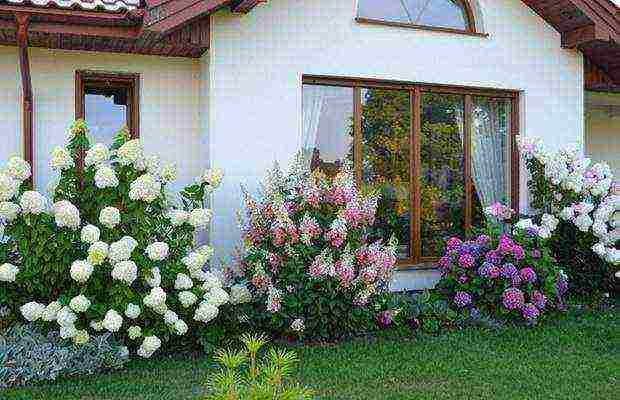
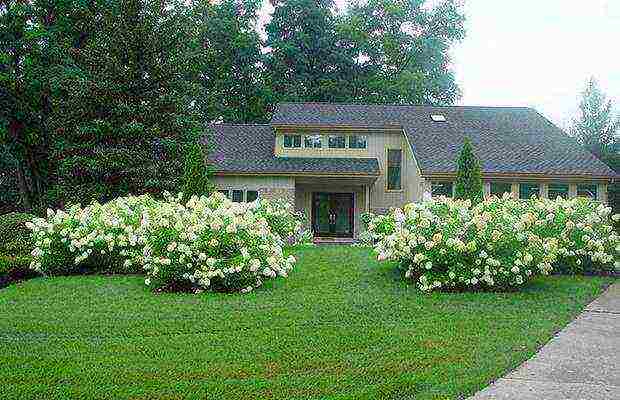
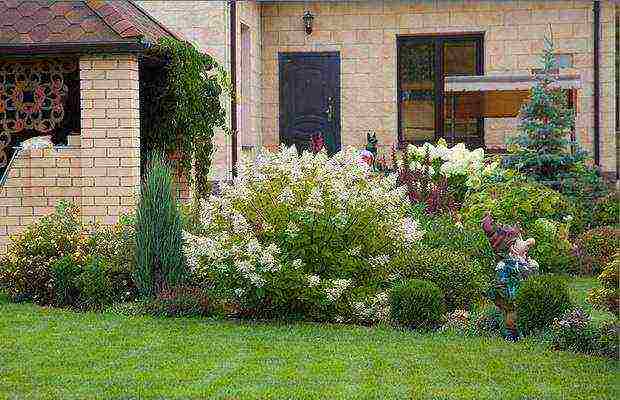
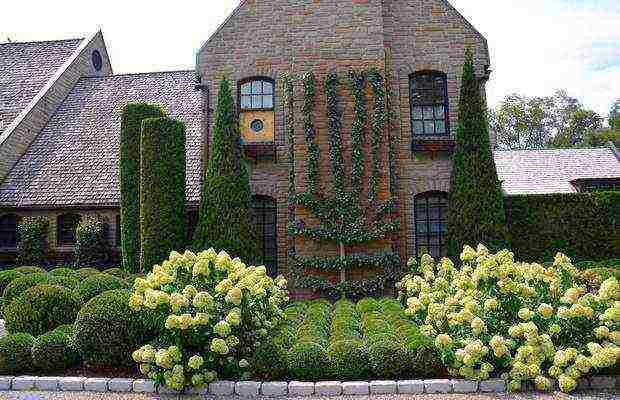
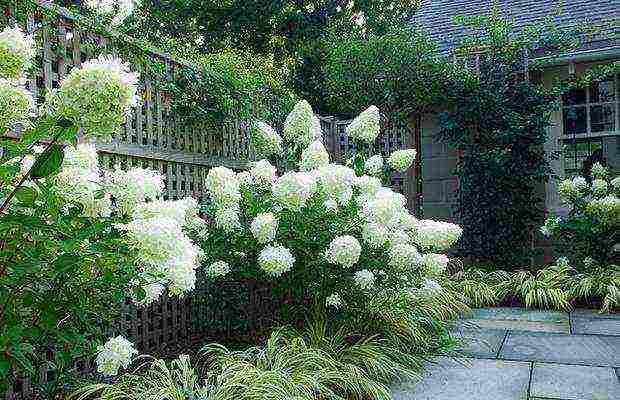


The panicle hydrangea is a flower that has come to the hearts of gardeners all over the world. They love hydrangea for its abundant and long flowering from spring to late autumn and is often called the flower "Endless Summer". Hydrangea is an absolute favorite when it comes to decorating a summer cottage with flowers. In Japan, hydrangea is considered a miracle of nature; residents poetically call it the flower of the purple sun.
The long flowering period begins in early summer and lasts until late autumn, almost until the first frost. Hydrangea attracts gardeners and landscape designers with a variety of shapes and colors.
Considering that panicle hydrangea belongs to the varieties of perennial plants and is unpretentious to climatic conditions, the use of shrubs in landscape design has become simply irreplaceable.
Hydrangea: varieties and types.
The hydrangea shrub has many types, they say that the total number of species and varieties of hydrangea is close to a hundred. The domestic gardener does not have much time on weekends to pay increased attention to flowers, which is why the least whimsical hydrangea varieties are considered favorites that do not require endless care:
- panicle hydrangea;
- hydrangea;
- large-leaved hydrangea.
Panicle hydrangea in the garden
The most common variety is panicle hydrangea. Panicle hydrangea grows completely freely in the wild on the Japanese islands, in China and in the far east of our homeland. Bright inflorescences in the form of panicles reach 25 centimeters.
Depending on the variety, panicle hydrangea can change the color of the inflorescence from white and pale green to bright pink by the end of flowering. The first flowers form at the end of June and bloom throughout the summer period, until the first October frost.
Benefits of panicle hydrangea.
Today on our agenda is panicle hydrangea. In the middle lane and even in the northern regions, these are the shrubs that winter wonderfully. The panicle hydrangea does not require any additional cover. It is only necessary to sprinkle the trunk circle with peat around the bush, covering the root system. Such events are enough for the bush to winter well. The main advantages of a hydrangea bush:
- Grows well in places where there is no sun in the shady areas of the garden;
- As a result of rapid growth, it begins to delight with flowers already 3-4 years after planting;
- An unpretentious variety of panicle hydrangea reacts steadily to low temperatures;
- In landscape design, it can be planted as a shrub, or as a standard small tree;
- An incredible variety of species and varieties for every sophisticated taste.
Panicle hydrangea care and reproduction
Note that almost all varieties of panicle hydrangea prefer the sun, but if the bush is in the open sun throughout the day, then flowering will proceed faster. The color scheme will also quickly change from soft beige to bright red.
Experienced gardeners recommend planting hydrangeas where at noon the plant is completely in the shade, or at least in an openwork shade. Fulfilling these conditions, the flowering of the plant will be quite long and more abundant. Even better, if the bush is generally planted on the side where the sun is until two o'clock in the afternoon, these are ideal conditions for a hydrangea.

Any type and variety of hydrangea has increased requirements for soil moisture. During dry summers, watering should be done twice a week. Usually, 30-40 liters should be planned for an adult bush, 20 liters for one watering is enough for a young hydrangea bush. The basic rule is the constant presence of moisture.
The second thing that you should definitely pay attention to is plant nutrition. All types of hydrangeas “love” to eat. It is necessary to use a full range of mineral fertilizers, it is desirable to combine it with Organic throughout the entire growing season.
Tip: Mulch the root system with pine bark, or the fall of the needles of any coniferous tree, and the plant will thank you with insanely beautiful flowering.
Sour soil has a positive effect on hydrangea inflorescences. The optimum level of soil acidity is 6-7 pH.
Panicle hydrangea. Top 10 best varieties.
Our top ten consists of the most popular varieties of panicle hydrangea.
1st place: panicle hydrangea Polar Bear.
First place is occupied by Polar Bear... Hydrangea is a well spreading shrub, the height of the shrub is 1.5 - 2 meters. The size of flowers, that is, one flower-bearing ear, is 40 45 cm. At the moment, this is the largest ear that can be found in the species diversity of panicle hydrangea.
The panicle hydrangea Polar Bear blooms with a palette of white-cream color, and ends in pale pink tones. Flowering begins in mid-July and ends in the southern regions in the month of October.
2nd place: panicle hydrangea Limelight.
In second place is deservedly a variety of panicle hydrangea with the name Limelight... Hydrangea paniculata Limelight fits the description of a compact and elegant bush. The height of the shrub reaches 120-150 cm. The size of the Limelight peduncles is 25-35 cm.
Limelight begins to bloom in a color scheme reminiscent of the exotic lime fruit. The tone of the flower is lemon-yellow, but not very pronounced, sometimes more greenish-yellow and it leaves already in winter with snow-white flowers. Agree, the spectacle is not usually beautiful.
The undeniable advantage is that the panicle hydrangea in our top 10 contains varieties that do not get wet from the rain. Flowers do not stick together, do not close, do not depend on winds or rains. Inflorescences always have a marketable, beautiful appearance throughout the season. Erect hydrangea bushes do not fall apart are always elegant, collected and insanely beautiful.
3rd place: Panicle hydrangea Vanilla Freise
Fireworks in the garden, you can't name it anymore. Unpretentious hydrangea paniculata Vanilla Fraze, which is planted and cared for in the open field, has won the special favor of connoisseurs of beauty. Vanilla Fries became the winner in 2015 at all specialized exhibitions and received many awards.
Vanilla Freise bush unusually beautiful, the height of the bush in central Russia does not exceed 150 cm. Peduncles reach a size of 30 cm. Paniculate hydrangea blooms Vanilla Freise is usually late June.
Note that almost all panicle hydrangeas begin to bloom in mid-July with a duration up to October. However, the Vanilla Freise variety begins to bloom in June.
Flowering begins Vanilla Fraze with the formation of white flowers. Gradually, literally after two to three weeks, you can observe how the lower part of the bud changes from a snow-white color to a pink tint. The cone of the flower remains completely white. The variety fully justifies the translation of its name and resembles vanilla ice cream.
On one bush of hydrangea Vanilla Fraz, there can be peduncles of different colors at the same time. There are flowers on the shrub that are just entering the phase of pink decoration, at the same time there are flowers that are almost completely covered in a pink palette. The spectacle is impressive and extraordinary, not a single person remains indifferent when passing by a bush of panicle hydrangea Vanilla Fraze.
4th place: panicle hydrangea Silver Dollar
The fourth grade that a lot of people like it Silver Dollar. The height of the bush exceeds 2-2.5 meters, for which it is especially popular among landscape planners. Silver Dollar perennial shrub is tall, powerful, strong. The shoots are straight, do not bend under the flowers and do not require a garter. The silver dollar blooms with snow-white buds, gradually turns pink and goes completely brown in winter.
The panicle hydrangea Silver dollar blooms from mid-July and holds the peduncle until September inclusive. The popular variety is in demand in landscape design and always looks winning. Wherever you put it, even if you put it in the shade, it will patiently endure all the hardships and will delight you throughout the summer.
5th place: panicle hydrangea Kuishi
Another variety worth paying attention to is the Kuishi Gartensia. The Kuishi variety is very common and very popular in Europe. This is one of those panicle hydrangeas that blooms early enough. The flowering period is from June to the end of September. A distinctive feature of Kuishi is its inimitable delicate aroma.
The bush contains both sterile and fertile flowers. As we mentioned, the extraordinary peduncle exudes a delicately delicate scent. The plant reaches a height of 2.5 meters. The bush looks more like a small tree. Convenient location in front of the windows of the house.
Gardeners of cities like to plant Kuishi hydrangea very much, since the variety is very patient with strong gas pollution of the streets. We draw the attention of landscape planners who will be associated with the greening of urban areas.
6th place: Bobo panicle hydrangea
The favorite variety of owners of small suburban areas is in sixth place with us and is called paniculate hydrangea Bobo. The variety was bred recently, but literally won the hearts of many, many hydrangea lovers.
A small variety with a bush size of only 60-70 cm. The Bobo hydrangea bush is unusually miniature and literally covered with peduncles that reach a length of 30 centimeters. Half bush flowers. It is literally a lush bouquet or, if you like, a flowerbed on a leg! It grows well even in a barrel.
Bobo blooms in early July and blooms until October. Of course, this is a very original bush. We recommend Bobo hydrangea especially for those with limited space. Be sure to pay attention to it. Experts describe it as a gentle and touching variety.
7th place: Panicle hydrangea Phantom
Another variety that took 7th place in our list is called Phantom. The absolute favorite of landscape designers has gained popularity because the bush grows quickly and efficiently. The height of the shrub reaches 2 meters, its width is not inferior and also grows up to 2 meters.
Popular in urban areas. The bush blooms with white buds, somewhere in July and keeps the bloom until October in the southern regions. Peduncle height is 25cm. Elegant and self-sufficient, we draw your attention to it as a representative of park culture.
8th place: panicle hydrangea Mega Mindy
A rare variety called Mega Mindy is in eighth place. This is a neat, small bush with a stem height of about 125 - 150 cm. The shrub blooms with white flowers and then it becomes cherry and richly pink buds. Closer to September, the peduncles turn bright red.
Hydrangea paniculata Mega Mindy grows quickly enough, remaining very miniature. Elastic stems free the gardener from the garter. Creates a good mood by adding bright colors to the garden design.
9th place: panicle hydrangea Grandiflora
And of course, Grandiflora, this variety has long been known and loved by gardeners. The height of the bush is 2.5 meters, sometimes a little less. Mainly sterile flowers on peduncles. It blooms unusually beautifully, the height of the peduncle is 30 centimeters. The bush has a cupped shape, does not fall apart, that is, it keeps the structure while remaining very elegant and beautiful.
Grandiflora can be planted in the foreground as a single planting or in a group. In any case, they look incredibly beautiful. Panicled Grandiflora, planted along the roads, pleases pedestrians with lush bloom.
10th place: panicle hydrangea Vims Red
And the last 10 on the list, closes our hit parade of hydrangeas, a variety called Weems Red. Let's just say he is not a frequent visitor to his personal plot. To the surprise of gardeners, it blooms with white flowers, early enough, around the end of June, and blooms in fact before the snow falls.
By mid-summer, the flower suddenly turns bright red. The color palette changes rapidly from white to bright scarlet. The variety smells surprisingly delicate, it has a sweet aroma. Insanely beautiful variety Weems Red, with a bush height of only 125 centimeters, that is, for a hydrangea, the variety is considered not high.
The flower stalks are small, but due to its bright color, Weems Red deserves the tenth place on our list. We draw our attention to it.
For today, this is the entire list of panicle hydrangeas. Of course, every gardener and gardener who loves panicle hydrangeas will find their own popular and favorite varieties. Perhaps you point this out in the comments. For our part, we chose varieties based on the popularity of purchasing seedlings, which are most often planted in the middle lane.
Panicle hydrangea care and pruning in a short video review:
